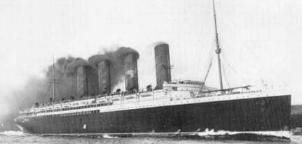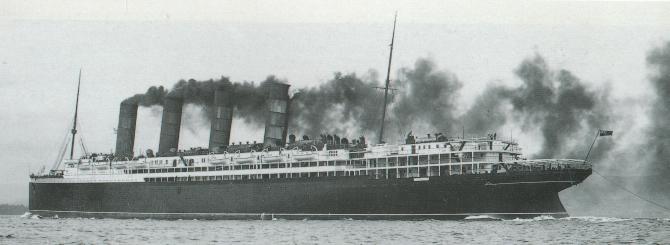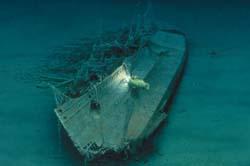|
LUSITANIA - Blue Ribbon 1907
|
|
HOME | BIOLOGY | FILMS | GEOGRAPHY | HISTORY | INDEX | INVESTORS | MUSIC | SOLAR BOATS | SPORT |
|
CONTENTS:
9. Discovery and riddle solving
1. THE BEGINNING
The race was on to gain dominance of the Atlantic crossing. The Late 1890s saw four new ships from Germany that threatened to put an end to the British dominance of the Atlantic. The ships produced by Germany were fast and luxurious.
Britain tried to retaliate by planning the commission of two ships in 1902. The ships would have to be the largest, fastest and most luxurious than ever built before. The Cunard Line decided (after serious negotiations) to let John Brown & Co. of Clydebank, Scotland build the Lusitania and Swan Hunter & Wigham Richardson on the River Tyne to build the Mauretania.
Before construction could begin there was a small problem of finance. £2,600,000 would be needed to build the ships. Negotiations started between the Cunard Line and the British Government. The Cunard Line wanted to secure a loan repayable over 20 years at low interest. The British Government agreed to grant the loan on the basis that the ships would be built to Admiralty specifications and that the ships could be called into active military service whenever the need arose. This would mean that the ships would have to be fast especially in active service because neither ship could be a sitting duck for enemy gunfire.
In fact in the Spring of 1909 her three bladed propellers were replaced with four bladed ones to give her extra speed. Bearing this in mind, Lord Inverclyde discussed the Cunard Agreement with a committee of experienced engineers in the September of 1903 to calculate what was needed to fulfil the contract.
Leonard Paskett produced the early designs for the two ships. Careful consideration was given to the layout of the ship. Most of the machinery was installed beneath the waterline. Her original plans gave the ships three funnels but the final plans gave them four.
2. CONSTRUCTION
Her construction was divided into two sections: Front and stern. Her forward end was almost completed before the stern had started. This allowed the designers extra time to arrange machinery in the engine rooms.
By the end of Spring 1905, the Lusitania's double bottom was in place. The work continued, paying particular attention to the stern of the ship. As a Naval Rescue Ship she would have to be quick as well as elegant. The Lusitania was launched by Lady Inverclyde on the 7th June 1906 at 12.30 p.m. The occasion was marked with 600 VIP guests.
The ship took only 86 seconds to launch. Work had taken 17 months so far. Her hull weighed 16,000 tons but once she was fitted with her boilers, engines, panelling etc, she would weigh 41,000 tons. Once completed Britain would have the grandest ships afloat. There was hope to regain the Blue Ribband.
It took just under one year to fit the ship out. Hundreds of workers worked around the clock trying to keep up with the strict deadlines placed on them by the British Admiralty. Once completed the Lusitania left the Clyde to commence her sea trials. No record has survived relating to what turned up during the trials but many alterations were made following the conclusion of the trials. Most of them were made to the stern section.
3. INSIDE THE SHIP
Like the Titanic to come, the Lusitania looked to many different historical ages and styles to decorate the different compartments and staterooms etc. Her first class lounge and Music room on the boat deck was completed in Georgian style with a yellow and green colour scheme top complement the mahogany panelling. There was a stain glass skylight overlooking the room. It was a delightful setting. A fireplace sat across the length of the room. Each room was fitted with magnificent enamels. The plasterwork was surpassed.
As can be imagined, the first class dinning room resembled kings' palace ballroom. It echoed the splendour of the French King Louis Seize. There was a dome at the top of the balcony. The dome contained segments depicting the four seasons re-enacted by Cherubim.
The sleeping quarters were also of fine fitting. The Lusitania had six standard size suites that had three rooms within each suite. She also had two "Regal Suites" which had two bedrooms, a sitting room, dinning room, private bath, lavatory and pantry. Again different periodic styles were used to decorate the rooms. Most rooms were French based design resembling some of the rooms in the Palace of Versailles. This gave the impression that all the rooms were different and individual. If you were a passenger, you were not actually on a ship, but staying in a very exclusive grand hotel.
The ensuite crooms were situated on the Promenade deck. Each had their own bath and toilet. They were not as large as the Regal Suites but a first class passenger could not even consider complaining.
Like the Titanic, the Lusitania followed the tradition of having a smoking room for the gentlemen to use after dinner to be parted from their respective partners to discuss the meaning of life. The rooms had an Italian 18th Century style. There was a stained glass barrel vaulted dome. There were two fires in the room actually burned coal. There were eight fires on the ship in total but six of them were electric.
There were many little luxurious aspects to her design. A first class elevator, double door to keep the heat in, reading rooms and of course the Verandah Café located on the boat deck.
As a point of interest, the designers originally wanted a gymnasium instead of the verandah café but this did not happen.
The second class rooms were not as luxurious as the first class ones but were still remarkable.
The second class dining room was one of the grandest rooms afloat of its day. Huge pillars had been placed in the dining room to add stability to the rooms.
The policy of the Cunard Line was to pride both the first and second class passengers with rooms not dissimilar to those they would find in the hotel rooms they would frequent. The different styles used throughout the ship certainly achieved this.
A smoking room was also included for the second class gentlemen. They enjoyed sitting under a barrel vaulted stained glass skyline.
The drawing room on the Promenade deck was furnished in the style of Louis Seize of France. The different shades of grey and rose complimented the satinwood furniture. The second class accommodation was fine as well. Their cabins were very spacious. Some were bigger than those of the first class were.
The third class cabins and rooms were almost standard compared to the first and second class. However, when they are compared to other transatlantic ships of the day, they would be seen to be very luxurious indeed - almost first class.
Most of their sleeping quarters were designed to hold between two and eight people. Life onboard would have been very different but the third class knew this and perhaps just accepted it.
4. LIFEBOAT CAPACITY
As per the Regulations of her day, the Lusitania carried 16 wooden lifeboats. By 1910 society had placed the building of liners so superior that they had become practically unsinkable. Basically the same reason why the Titanic only carried the number of boats it did.
However, following the loss of the Titanic, the Lusitania was fitted with 48 boats (22 wooden and 26 collapsible). Every boat was fitted with 2 chains to anchor them to the deck. This would prove disastrous when the ship sank because the chains would have to be released before the boats could be swung clear of the ship. When the Lusitania was sinking many of the chains were not released and thus preventing the boats from being launched successfully. Many boats went down with the ship.
5. MAIDEN VOYAGE
On the 7th September 1907 under the command of Captain James B. Watt, the RMS Lusitania sailed on her maiden voyage to New York. She carried over 3,000 passengers and crew. Her passengers were delighted with the new ship. The standards of accommodation and services were well documented. Most third class passengers enjoyed the voyage. Dinning on her was like eating in the best restaurants or hotel anywhere.
She arrived in New York on the 13th September 1907. Her voyage lasted 5 days and 54 minutes. She did not recapture the Blue Ribband on this occasion, which was a great disappointment of the authorities and owners.
Her second voyage was quicker. She averaged 23.993 knots crossing the Atlantic in less than 5 days. She recaptured the Blue Ribband. The British held the record for the next 22 years until the German liner Bremen earned it in 1929.
6. THE LAST VOYAGE
In August 1914 World War One broke out. The day of anticipation finally arrived when the British Navy needed the ship for wartime service. The Lusitania had to be refitted for the purpose. Her four funnels were fully painted black to conceal her identity from enemy ships. The Lusitania left New York on 1st May 1915.
The authorities warned her that she would inevitably cross the war zone to reach Liverpool. Despite warnings, she left New York after several delays just after 12.30 p.m. Passengers from the RMS Cameronia were transferred to the Lusitania when it was requisitioned early that morning.
Lusitania's new Captain William Turner sailed her for five days without the need for alarm.
It was now Friday 7th May 1915. She had reached the War Zone. The usual precautions of blackening out the portholes and doubling the watch were obeyed.
The lookouts were tentatively at their posts. At about 1.30 p.m. Leslie Morton saw the torpedo heading towards the Starboard side travelling at about 22 knots. He gave the alarm stating "Torpedo coming in the Starboard side". The Bridge was slow in reacting to his warnings.
Another lookout, Thomas Quinn also said that the torpedo and sounded the alarm. It was too late. The torpedo struck the ship and detonated before Turner could do anything. Power was suddenly lost. The watertight door could not be closed. Radio distress signals had to be sent using battery power.
At 2.10 p.m. after lunch the passengers were eagerly waiting for their desserts when they heard:
"&ldots;the sound of an arrow entering the canvas and straw of a target magnified a thousand times" and "a pearl of thunder" and "the slamming of a door".
A second explosion came within seconds. Suddenly the ship took a 15º list to Starboard, which began to sharpen to 16º then 17º etc until the list reached 25º - a point at which the ship could not survive. The list had become so severe that the Officers could not swing the lifeboats clear of the ship.
Panic had set in amongst the passengers. Some jumped into the water trying to flee for their lives. Captain Turner jumped into the water when the Bridge was flooding. He swam for three hours before finding a lifeboat to climb into. Within 18 minutes the ship had rolled over and sunk with 1,195 passengers. Only 289 bodies were recovered. 764 people survived.
7. WHAT SANK HER
May had proved to be a busy month for the Germans. In particular for a German Submarine U20 commanded by Captain Schwieger. His mission was to seek and destroy enemy vessels. He had already torpedoed and sank three ships: The Earl of Lathom, the Candidate and the Centurion.
Fuel was running low on the U-boat and Schwieger decided not to head for Liverpool as was originally planned but to head back. It was inevitable that the U20 and the Lusitania would pass each other at some point in the Irish Channel.
On the 7th May 1915, the U20 was still patrolling the Irish Channel. At 1.20 p.m. the Captain of the Submarine wrote in his log. "Starboard ahead four funnels and two masts of a steamer with course at right angles" When the Lusitania was in firing range he fired a torpedo which ultimately hit the ship.
8. AFTERMATH
Only eight of the 22 wooden boats aboard were launched. Some made it to Queenstown, Ireland. The rest of the boats were either damaged during the rapid sinking or were not lowered at all because the chains prevented easy release and went down with the ship.
9. DISCOVERY AND RIDDLE SOLVING
Following the sinking, like the HMHS Britannic, many questions were being asked.
a) Why did she sink so fast after her strong construction? b) Why did the survivors recall two explosions when the German U boat log indicated only one torpedo was fired? c) Did the ship carry munitions in its cargo hold that exploded? Dr. Robert Ballard set out on a quest to locate the wreck, explore it and try to answer some of the questions left unanswered.
He believed strongly that "illegal high explosives in the ships magazine had probably caused the tragedy". To him it made perfect sense that the torpedo hit the starboard side of the ship - the explosion ignites the arms and explosives stacked in the ship's magazine and causes a second explosive.
He did however, have problems with the recalled position of the impact area. Eyewitness accounts stated that the torpedo hit below or just in front of the Bridge. If it did the magazine would have been too far away to have been hit (the bulkheads were in the way). Did the boilers explode? Often as ships sink, cold water pours over the extremely hot boilers making then explode. It seemed possible at least.
Ballard learned that the Lusitania lay along a bearing of about 230º. The great hull had been torn open during the sinking. A fracture was visible from the sonar running between the 3rd and 4th funnel. The structural damage seemed to bear a resemblance to where the Titanic's damage occurred where the huge dinning room and first class lounge were located.
With the help of Jason (see Discovery of the Titanic) and modern 3D imaging systems, they were able to superimpose a 3D image of the great ship in her prime and see the areas most affected by the sinking.
Jason was manoeuvred to the Portside of the hull, where a previous diver, John Light had reported the main damage caused by the second explosion. Ballard could not see the hole. Fishing nets made the exploration difficult. However, avoidance with the nets was impossible and the underwater subs did get caught in the nets.
The exploration continued. They came across some of the ship's distinctive vents, a boat winch, floor tiles and the ships whistle etc, a typical debris field. As with the Britannic and Titanic, the bow is bent upward caused by the great impact when she hit the bottom.
The Foredeck is covered with fishing nets but windless brake, small crane and a section of the great anchor chain remains intact. There is even rope around a bollard.
Once Ballard had photographed the wreck he could turn his attention on what actually sank her. Ballard explored the total area of the magazine. It was clear that it did not explode. It was still intact. The second explosion could not be attributable to the magazine exploding.
Ballard realised that if the torpedo had struck beneath the Bridge, the torpedo would have hit the coalbunkers so it could have been the sparks from the torpedo that set the bunkers on fire and coal dust caused a huge explosion. Within minutes of the coal dust explosion the ship would develop a list to starboard and then sank.
....... The World in Your Hands
330ml alu Earth Can
|
|
This
website
is Copyright © 1999 & 2007 NJK. The bird |
|
AUTOMOTIVE | BLUEBIRD | ELECTRIC CARS | ELECTRIC CYCLES | SOLAR CARS |



